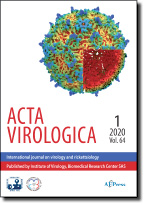Journal info
|
||
Select Journal
Journals
Bratislava Medical Journal Endocrine Regulations General Physiology and Biophysics Neoplasma Acta Virologica Current articles 2023 2022 2021 2020 2019 2018 2017 2016 2015 2014 2013 2012 2011 2010 2009 2008 2007 2006 2005 2004 2003 Studia Psychologica Cardiology Letters Psychológia a patopsych. dieťaťa Kovove Materialy-Metallic Materials Slovenská hudbaWebshop Cart
Your Cart is currently empty.
Info: Your browser does not accept cookies. To put products into your cart and purchase them you need to enable cookies.
Acta Virologica Vol.59, No.3, p.265-275, 2015 |
||
| Title: Porcine epidemic diarrhea virus M protein blocks cell cycle progression at S-phase and its subcellular localization in the porcine intestinal epithelial cells | ||
| Author: X. G. XU, H. L. ZHANG, Q. ZHANG, J. DONG, Y. HUANG, D. W. TONG | ||
| Abstract: Porcine epidemic diarrhea (PED) caused by virulent strains of porcine epidemic diarrhea virus (PEDV) is a highly contagious enteric disease of swine characterized by severe enteritis, vomiting, and watery diarrhea. This study investigates the subcellular localization and function of PEDV M protein through examination of its effects on cell growth, cell cycle progression, and interleukin 8 (IL-8) expression. Our results revealed that the PEDV M protein is localized throughout the cytoplasm. The M protein altered swine intestinal epithelial cell line (IEC) growth and induced cell cycle arrest at the S-phase via the cyclin A pathway. The S-phase arrest is associated with a decrease in level of cyclin A. Furthermore, our results revealed that the M protein of PEDV does not induce endoplasmic reticulum (ER) stress and does not activate NF-κB which is responsible for IL-8 and Bcl-2 expression. This is the first report to demonstrate that the PEDV M protein is localized in the whole cell and induces cell cycle arrest at the S-phase. This study provides novel findings in the function of M proteins of PEDV. |
||
| Keywords: PEDV M protein; S-phase; cyclin A; subcellular localization; IL-8 | ||
| Year: 2015, Volume: 59, Issue: 3 | Page From: 265, Page To: 275 | |
| doi:10.4149/av_2015_03_265 |
||
|
|
 download file download file |
|

